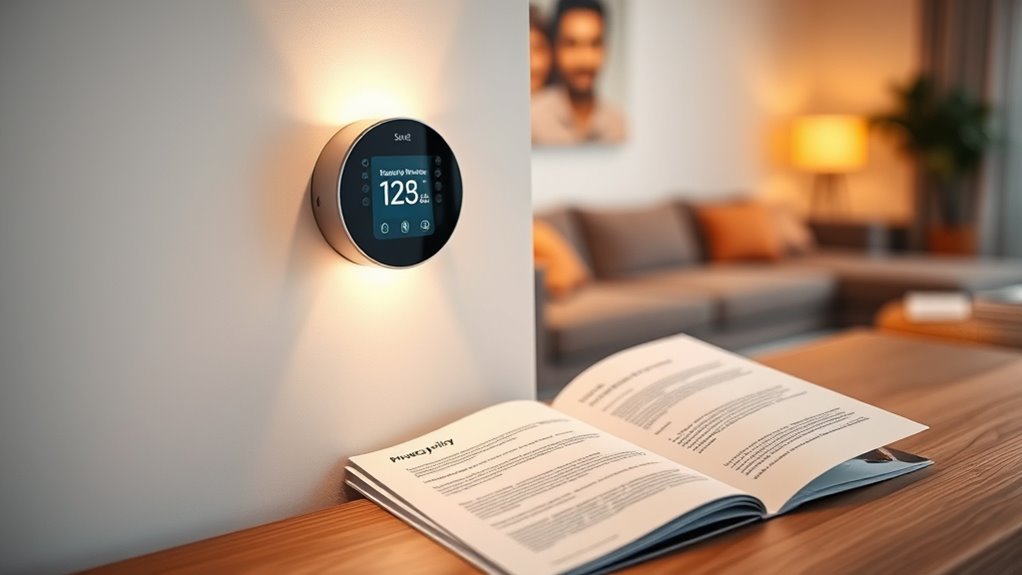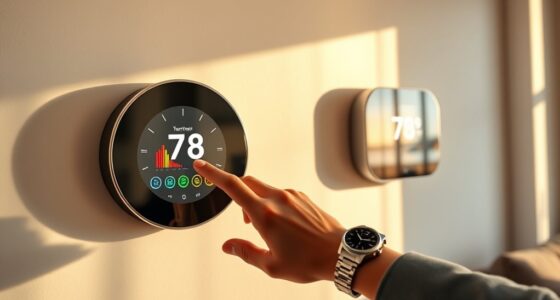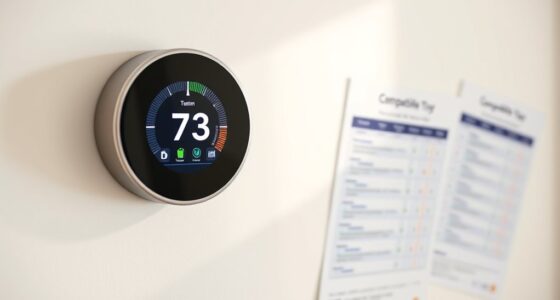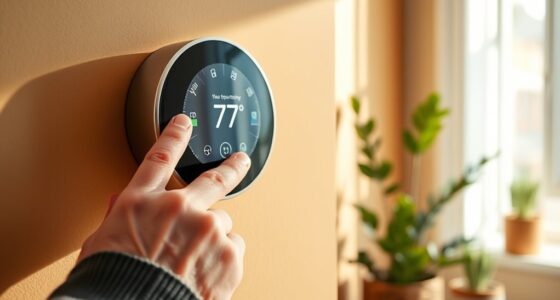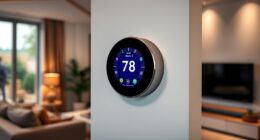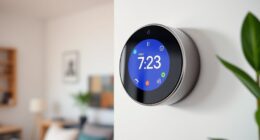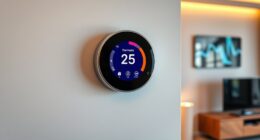Understanding smart thermostat privacy policies helps you know what personal information is collected, like your routines, location, and preferences. These devices gather data to improve features and personalize your experience, but policies may also share your info with third parties or for ads. You usually give consent during setup, and you can often customize privacy settings to limit data sharing. Staying aware of policy updates guarantees you protect your privacy. If you keep exploring, you’ll learn how to better manage your data.
Key Takeaways
- Review the privacy policy to understand what personal data is collected, such as location and occupancy patterns.
- Check if the device shares data with third parties or uses it for targeted advertising.
- Use app or device settings to customize privacy controls and limit data sharing options.
- Stay informed on policy updates to know how data handling practices may change over time.
- Balance device features with privacy by selecting thermostats with transparent policies and clear data management options.
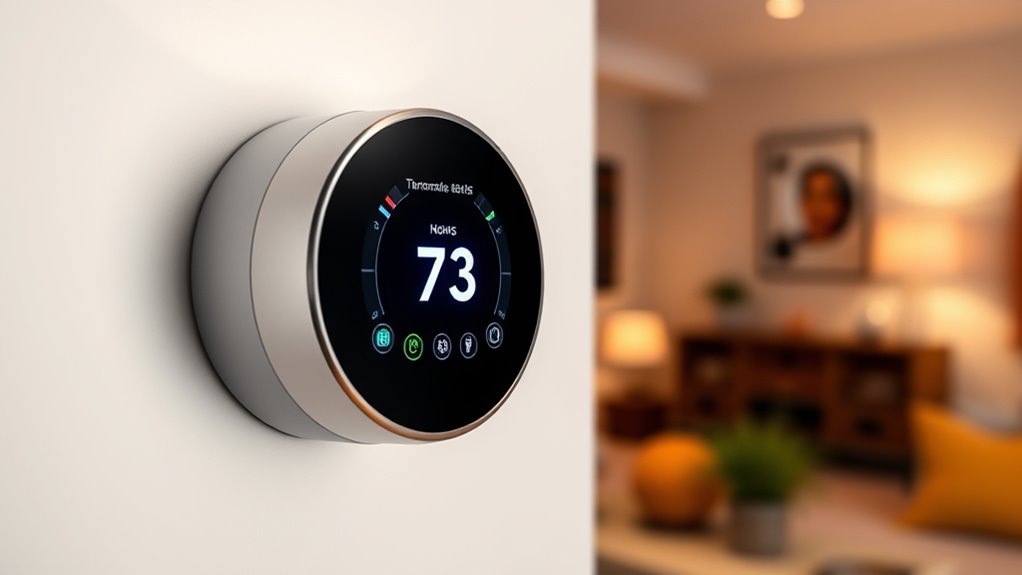
Smart thermostats have become a popular way to save energy and enhance home comfort, but understanding their privacy policies is essential before installation. When you install a smart thermostat, you’re giving it access to a lot of personal information, from your daily routines to your household habits. Recognizing how these devices handle data collection is key to protecting your privacy. Manufacturers often collect data to improve device functionality, personalize your experience, or provide tailored energy-saving tips. However, this data collection can include sensitive details like your location, occupancy patterns, and even your comfort preferences. Before you agree to these terms, it’s important to review the privacy policy carefully to understand what specific data is being collected and how it will be used.
User consent plays a central role in the privacy practices of smart thermostats. Most companies require you to accept their privacy policy before you can start using the device. This consent is usually obtained through an agreement during the setup process, but it’s often buried in lengthy legal language. You should take the time to read these policies thoroughly, so you know exactly what you’re agreeing to. Sometimes, companies will seek additional consent for specific data collection practices, like sharing your information with third-party partners or using data for targeted advertising. Being aware of these details empowers you to make informed decisions about your privacy. If a policy seems overly invasive or unclear, you might consider whether you’re comfortable with the data collection practices involved.
Furthermore, many smart thermostat providers offer options to customize your privacy settings. You can often limit data sharing or disable certain data collection features through the device’s app or settings menu. Taking these steps allows you to retain more control over your personal information. It’s also beneficial to understand data handling practices to see how your information is stored and protected. Additionally, reviewing privacy policies regularly helps you stay informed about any updates or changes in data collection. Keep in mind that restricting data collection may impact some features or the overall performance of your smart thermostat. Still, balancing privacy with functionality is vital. If privacy is a top priority, look for devices with transparent policies and clear options to manage your data preferences. Remember, your consent isn’t just about clicking “agree”—it’s about understanding what you’re agreeing to and ensuring it aligns with your comfort level. Being aware of data collection practices helps you make more informed choices about your smart home devices.
Frequently Asked Questions
How Long Do Companies Retain My Thermostat Data?
You might wonder how long companies keep your thermostat data. Typically, they retain it for as long as necessary to provide services, improve functionality, or comply with legal obligations. They use data encryption to protect your information and rely on your user consent to store and process your data. Always review their privacy policies to understand specific retention periods, ensuring you’re aware of how long your data is stored and protected.
Can I Delete My Smart Thermostat Data Permanently?
Imagine losing control over your smart thermostat data—you might wonder if you can delete it permanently. The truth is, your data ownership depends on the company’s policies, and often, you need to give explicit user consent to remove your information. Some companies let you delete your data, but others retain it for legal or operational reasons. Always check your privacy settings and give clear consent to protect your privacy.
Are Third-Party Apps Allowed to Access My Thermostat Information?
Third-party access to your thermostat info depends on the app permissions you grant. Usually, you must explicitly allow third-party apps to access your device, and they can only do so within the limits you set. Always review app permissions carefully before installing or linking new apps. If you’re concerned about privacy, disable third-party access or revoke permissions through your thermostat settings to keep control over your data.
What Are My Rights Regarding Data Sharing With Third Parties?
Imagine your data as a precious key. You’re entitled to know how it’s shared, with clear consent requirements, just like granting permission for someone to hold that key. You have the right to access your data (data portability) and control who gets it. You can request to move or delete your information, ensuring your privacy stays protected. Stay informed, and always review privacy policies before sharing your thermostat data.
How Secure Is My Data From Hacking or Unauthorized Access?
You might wonder how secure your data is from hacking or unauthorized access. Devices often use encryption to protect your information, making it difficult for hackers to intercept. Additionally, user authentication methods like strong passwords or two-factor authentication add extra layers of security. However, no system is completely foolproof. Regularly updating your device’s software and following best security practices help keep your data safer from threats.
Conclusion
By now, you’re like a savvy navigator steering through the maze of smart thermostat privacy policies. Remember, these policies are your map—guiding you to protect your personal data and keep your digital home secure. Stay vigilant, read the fine print, and don’t hesitate to ask questions. With awareness as your shield, you’ll sail smoothly through the connected world, ensuring your privacy remains as cozy as your perfectly heated home.
